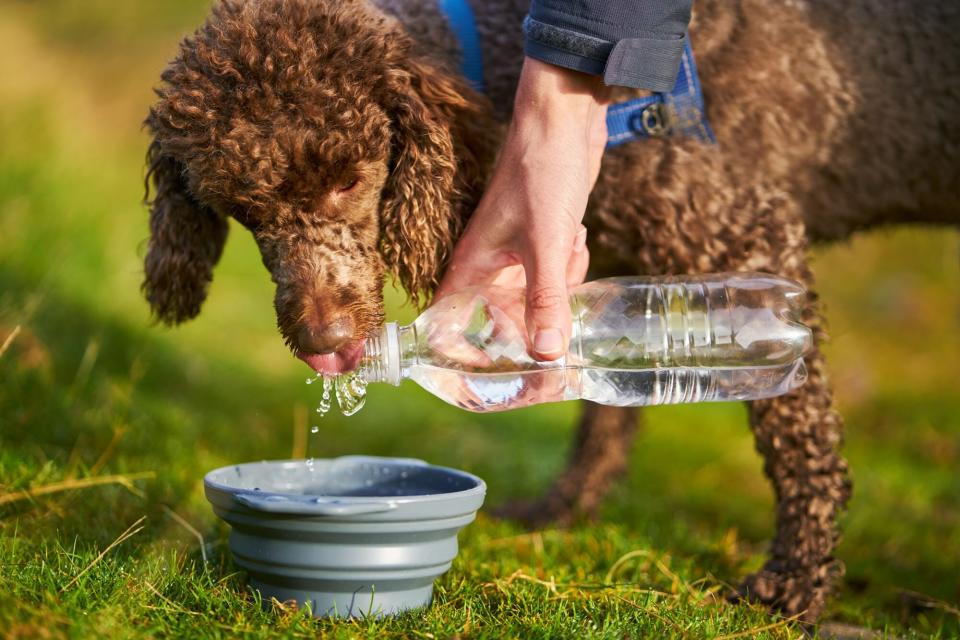Heat Exhaustion in Dogs Can Be Dangerous, But You Can Protect Your Pup as Temps Rise
TABLE OF CONTENTS
On This Page
How Dogs Get Heat Exhaustion
Heat Stroke vs. Heat Exhaustion
Signs of Heat Exhaustion
How to Treat Heat Exhaustion
Long-Term Effects of Heat Exhaustion
Preventing Heat Exhaustion
Heat exhaustion in dogs is a risk that arrives along with warm summer temperatures. Dogs can overheat when they're outside in hot weather for too long without a way to cool off, resulting in panting, vomiting, or even death.
But there's plenty you can do to prevent dog heat exhaustion. You can simply limit your dog's time outside, or take more trips to the puppy pool or your favorite shady spot. Just be sure you know how to spot the signs of your dog overheating—just in case.
How Do Dogs Get Heat Exhaustion?
People get sick from the heat and so do dogs. Dogs are more susceptible to heat exhaustion than people because of how the canine natural cooling system works. Instead of sweating like we do, they pant or lay on cool surfaces to regulate their temperatures, says Susan Boeving, DVM from Southlake Crossing Animal Clinic in Southlake, Texas.
"However, that may not be sufficient in some situations and a potentially serious health situation could develop," she says.
Remember, dogs run hotter than we do—their body temperatures sit between 101 and 103 degrees Fahrenheit—so they can overheat at lower temperatures. Depending on the dog, it can get dangerous for them around 85 degrees.
Brachycephalic (flat-faced) dog breeds like pugs and bulldogs, and dogs who are older, overweight, or not acclimated to heat are at greater risk for heat exhaustion. Same goes for hairless dogs and dogs who have long, thick coats or short, thin coats.
RELATED: Here's How To Protect Your Dog's Paws From Burning on Hot Surfaces
Heat Stroke vs. Heat Exhaustion in Dogs
Boeving says veterinarians don't always differentiate between heat stroke and heat exhaustion because dogs can respond several different ways to their elevated body temperatures, especially considering their breed, health, and where they live.
"For example, if your dog overheats and his temperature rises from the norm of 101 to 102 degrees to over 105 degrees, he may experience heatstroke and potentially die. But some dogs with the same temperature may be fine after spending time in a cool room with water," she says.
Signs of Heat Exhaustion in Dogs
Overheating signs vary, but all are red flags. According to the ASPCA, watch for signs such as:
Excessive panting or difficulty breathing
Increased heart and respiratory rate
Bloody diarrhea
Drooling
Mild weakness
Stupor or collapsing

Duncan_Andison / Getty
How to Treat a Dog With Heat Exhaustion
If you see signs your dog is overheating, get him to a cool spot right away, Boeving says. The keyword is cool—not cold. Avoid ice.
"Wet his body down with towels presoaked with cool—not cold or icy—water, and keep his head elevated so no water enters his nose or mouth," she says. "Repeat this process until his temperature drops to 103 degrees. Avoid ice baths, ice packs, or cooling your pet too quickly. These practices can cause the blood vessels to constrict which actually slows heat loss."
Boeving advises giving your dog cool water to drink, but not an excessive amount (or he may vomit), and refraining from giving him aspirin or other human medications unless instructed by a veterinarian.
She also recommends calling your veterinarian or emergency animal clinic for additional guidance (like how to check for signs of shock) and then heading there for further help. Even if your dog seems better, he needs to be checked for internal damage, likely treated for lost fluids, and then monitored for complications.
RELATED: Dehydration in Dogs: Causes, Symptoms, and How to Get Your Dog Rehydrated
Long-Term Effects of Heat Exhaustion in Dogs
Many dogs will recover from heat exhaustion—or even heat stroke if it gets that advanced, Boeving says. But you still need to watch out for long-term problems that can pop up.
Heat stroke, for instance, can lead to kidney, heart, and neurological problems as well as blood clots because the stroke affects all your dog's major organs.
"The best way to minimize complications and improve your pet's chances for a full recovery is to have him seen by your veterinarian as soon as there are concerns about overheating," Boeving says.
Preventing Heat Exhaustion in Dogs
To protect your dog on hot, humid days, Boeving suggests keeping these tips in mind.
Schedule walks and outdoor playtime for early mornings or late evenings when it's a bit cooler, or stay inside. When your dog goes outside, don't let them stay out for long and watch for signs of overheating.
When outside, take breaks in the shade. Encourage your dog to drink water as panting increases dehydration. To make that more manageable on the go, pack a collapsible water bowl that folds up in your pocket or clips to your backpack.
On hot days, swap walks for splashing around in a pet pool or let your dog run through the water sprinkler. Or better yet, find something fun indoors to do together for exercise.
Don't leave your dog in a car during hot weather. According to The Humane Society of the United States, all it takes is 10 minutes—on an 85-degree day—for the temperature in a car to reach 102 degrees. And that's with the windows opened slightly.
